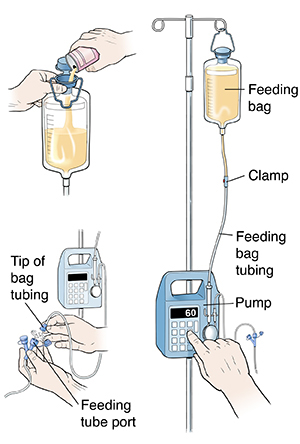Continuous Tube Feeding
A person who can’t tolerate much food at once needs to be fed continuously. Some people are fed day and night. Others are fed only during waking hours or only at night. Start the feedings at the same time each day. Before feeding, make sure the food is at room temperature. After each feeding, cover and refrigerate any leftover food.
There are different types of feeding bag tubing and feeding tubes. One has a connection that lets you plug or push the feeding bag tubing tip into the feeding tube port. A newer type has a twist-on safety connector. The twist-on feature means you must use a specific type of feeding bag tubing that twists onto your feeding tube port. Check with your care team to make sure you are following the steps for your specific type of feeding bag tubing and feeding tube.

Start the first daily feeding with a clean feeding bag. After the last feeding, run warm, soapy water through the bag and tubing. Rinse them well and hang them to dry.
1. Filling the feeding bag
-
Turn the pump to STOP/OFF.
-
Close the clamp on the feeding bag tubing.
-
Pour the prescribed amount of liquid food into the feeding bag.
-
Hang the feeding bag on the pole above the pump. Make sure the bag tubing hangs straight.
-
Open the clamp slowly. Let a small amount of food run through the end of the tubing into a measuring cup or bowl. This clears air out of the tubing and helps prevent gas.
-
Close the clamp on the tubing.
2. Connecting the feeding bag
-
Put the feeding bag tubing through the front of the pump.
-
Connect the feeding bag tubing to the feeding tube port.
-
Plug-in port. If you have a feeding tube with a plug-in type of port, push the tip of the feeding bag tubing into the feeding tube port.
-
Twist-on port. If you have a twist-on feeding port, screw the feeding bag tubing onto your feeding port.
-
Open the clamp on the feeding bag tubing.
3. Turning on the pump
Checking residuals: You may be told to check the amount of feeding left in the stomach (residuals) at given times. If so, you’ll be told what to do for different amounts of residuals. This can vary by care team and healthcare provider. Follow your care team's specific instructions if you are advised to check residuals.
During your feeding and for at least 30 minutes after, stay upright or reclining at not less than 30°. This lowers the risk that the feeding solution will drain incorrectly and cause aspiration. Aspiration is when you breathe the feeding solution into your lungs. This can cause pneumonia.
Online Medical Reviewer:
Marianne Fraser MSN RN
Online Medical Reviewer:
Rajadurai Samnishanth
Online Medical Reviewer:
Rita Sather RN
Date Last Reviewed:
9/1/2023
© 2000-2025 The StayWell Company, LLC. All rights reserved. This information is not intended as a substitute for professional medical care. Always follow your healthcare professional's instructions.